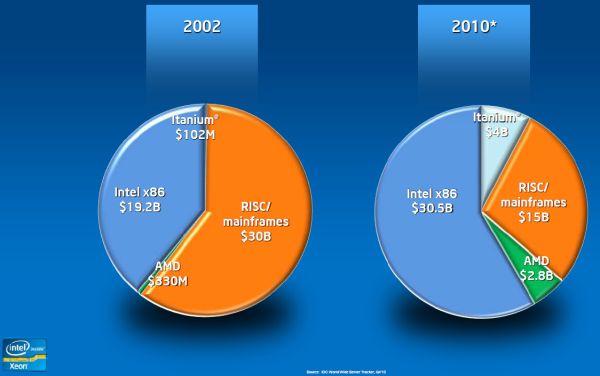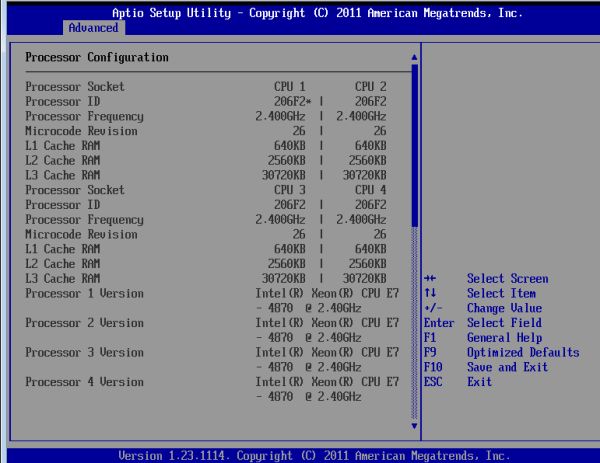Westmere-EX: Intel's Flagship Benchmarked
by Johan De Gelas on May 19, 2011 1:30 PM EST- Posted in
- IT Computing
- Intel
- Xeon
- Cloud Computing
- Westmere-EX
Intel's Best x86 Server CPU
The launch of the Nehalem-EX a year ago was pretty spectacular. For the first time in Intel's history, the high-end Xeon did not have any real weakness. Before the Nehalem-EX, the best Xeons trailed behind the best RISC chips in either RAS, memory bandwidh, or raw processing power. The Nehalem-EX chip was well received in the market. In 2010, Intel's datacenter group reportedly brought in $8.57 billion, an increase of 35% over 2009.
The RISC server vendors have lost a lot of ground to the x86 world. According to IDC's Server Tracker (Q4 2010), the RISC/mainframe market share has halved since 2002, while Intel x86 chips now command almost 60% of the market. Interestingly, AMD grew from a negligble 0.7% to a decent 5.5%.
Only one year later, Intel is upgrading the top Xeon by introducing Westmere-EX. Shrinking Intel's largest Xeon to 32nm allows it to be clocked slightly higher, get two extra cores, and add 6MB L3 cache. At the same time the chip is quite a bit smaller, which makes it cheaper to produce. Unfortunately, the customer does not really benefit from that fact, as the top Xeon became more expensive. Anyway, the Nehalem-EX was a popular chip, so it is no surprise that the improved version has persuaded 19 vendors to produce 60 different designs, ranging from two up to 256 sockets.
Of course, this isn't surprising as even mediocre chips like Intel Xeon 7100 series got a lot of system vendor support, a result of Intel's dominant position in the server market. With their latest chip, Intel promises up to 40% better performance at slightly lower power consumption. Considering that the Westmere-EX is the most expensive x86 CPU, it needs to deliver on these promises, on top of providing rich RAS features.
We were able to test Intel's newest QSSC-S4R server, with both "normal" and new "low power" Samsung DIMMs.
Some impressive numbers
The new Xeon can boast some impressive numbers. Thanks to its massive 30MB L3 cache it has even more transistors than the Intel "Tukwilla" Itanium: 2.6 billion versus 2 billion transistors. Not that such items really matter without the performance and architecture to back it up, but the numbers ably demonstrate the complexity of these server CPUs.
| Processor Size and Technology Comparison | ||||
| CPU | transistors count (million) | Process |
Die Size (mm²) |
Cores |
| Intel Westmere-EX | 2600 | 32 nm | 513 | 10 |
| Intel Nehalem-EX | 2300 | 45 nm | 684 | 8 |
| Intel Dunnington | 1900 | 45 nm | 503 | 6 |
| Intel Nehalem | 731 | 45 nm | 265 | 4 |
| IBM Power 7 | 1200 | 45 nm | 567 | 8 |
| AMD Magny-cours | 1808 (2x 904) | 45 nm | 692 (2x 346) | 12 |
| AMD Shanghai | 705 | 45 nm | 263 | 4 |












62 Comments
View All Comments
L. - Thursday, June 2, 2011 - link
Err... no it's not the same price.Besides, "a lot worse on benchmarks" is a huge pile of shit, if that was the case, why would Cray and others take Opteron for SC ?
Why would anyone, in fact, go out of their habits to buy a chip from the underdog ?
Believe me, even if you see a lot favoring Intel, there's a lot favoring AMD that's less shown but there regardless..
As I said, same perf/watt on the anand benchmarks for two chips that are a die shrink away from each other... this is ludicrous.
Casper42 - Thursday, May 19, 2011 - link
I had heard previously that 32GB DIMM Support (Quad Rank) was actually coming from Westmere CPUs themselves as opposed to Mobo or Chipset.The part of the review where you talk a little about the Hardware Intel sent over makes it seem like the Server is the part responsible for the 32GB DIMM support.
Perhaps you could research and clarify a little?
Michael REMY - Friday, May 20, 2011 - link
cinebench benchmark is missing so much...My lord anandtech...?
why didn't you test cinebench on this god machine ?
why not ?
why do you thinh this kind of machine is preferend to server/network instead 3D application ?
even a single cinebench (which is a x64 portable application in windows ) need less 15 minutes to download, unpack, run,re-rerun the test...
why no 3d benchmark in this test. i 'm so desapointed...
:-(
JohanAnandtech - Saturday, May 21, 2011 - link
I'll run that for you, but Cinebench is limited to 64 threads. Other suggestions you would like to see?Veteran_69 - Friday, May 20, 2011 - link
Looking at the power consumption and results. It is clear to me that AMD is better in the Perf/Watt performance. Even with an outdated platform (Why no tests with magny-cours again?)they manage to perform better with the same currentdraw.
JohanAnandtech - Saturday, May 21, 2011 - link
"(Why no tests with magny-cours again?)"What do you mean by this? The AMD Opteron 6174 is one of the best Magny-cours available.
Veteran_69 - Friday, May 20, 2011 - link
Since my previous comment was deleted for whateve reason. I'll rephrase.Why arent there any perf/wat figures? If you look at the data it is Clear that an old AMD platform offers superior Perf/Watt. I also noticed any tests with Magny-cours as a competition is missing?
silverblue - Friday, May 20, 2011 - link
The Opteron 6174 and 6176 are Magny-Cours processors, so they were indeed tested. I believe the choice in using the 6174 for the majority of the review would be down to the 6176's higher TDP as discussed at the following link:http://www.anandtech.com/show/2978/amd-s-12-core-m...
behold4r - Friday, May 20, 2011 - link
I have very much enjoyed reading this article as well as the previous one about the 4p systems of intel which are in fact very interesting i must say, because benchmarks about such systems are very rare to find on the net.I would only like to ask anandtech.com if it is possible to see any rendering benchmarks on such a system. I am using some 3D software and i would very much like to see how the AMD system with the 48 cores is doing when rendering (with mental ray and vray preferably).
I focus on the AMD server system because it really is a very good price per performance example whereas Intel is indeed ahead performance wise, but the prices for an Intel 4P system are astronomical to say the least. I personally believe that very few companies need such a thing, while most of them can do well with an AMD system.
And since you are talking about virtualization, if a company needs more power, just buy another 4P AMD system, the overall result will be a faster system (by far) than a single Intel one, while having the price of a single Intel server! (3K+ for a single intel cpu chip is just outrageous, intel charges like there is noone else on this planet with an equivalent product, at least for the x86 market). Though two AMD systems will use a little more power than a single Intel one (~1150W for 2 AMD servers instead of ~900W for a single Intel based on the info of this article, which is not that much ahead if you think of the performance you gain).
Then again there are the infrastructure costs (more 10 gig ports for the extra system, extra UPS load thus more UPS power to handle the extra system, extra space in the rack, and of course extra cooling for the 2nd system). Which I think these issues are the real deal and hence will make the final decision.
Anyway, that's all i wanted to say. Again i only wanted to ask for some rendering benches, if it such a hustle than at least a mere cinebench 11.5 would be fine.
Thanks
Kiijibari - Saturday, May 21, 2011 - link
Where is AES in the CPU-Z screenshot, is it not supported ?Would be very strange for a server CPU, wouldn't it ?